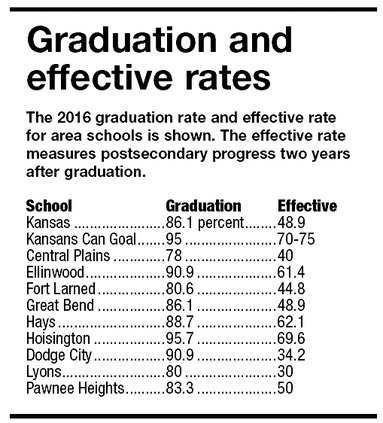Great Bend USD 428’s graduation rate averaged 81 percent over the five-year period of 2012 to 2016, according to information from the Kansas State Department of Education. Although that is well below the goal of 95 percent, it is comparable with other school districts statewide, Assistant Superintendent John Popp said.
The KSDE’s Kansans Can initiative notes that high school graduation is a milestone for students, but it’s not the finish line. The state now tracks students for two years after graduation with a goal of also raising the percentage of students who receive some sort of postsecondary education.
The “effective rate” is a number found by multiplying the graduation rate by the percentage of students who met one of four outcomes within two years of high school graduation:
• Student earned an Industry Recognized Certification while in high school
• Student earned a Postsecondary Certificate
• Student earned a Postsecondary Degree
• Student enrolled in Postsecondary in both the first and second year following high school graduation
At the Sept. 10 Great Bend USD 428 Board of Education meeting, Popp said the district’s numbers aren’t great. However, Great Bend is surpassing levels predicted for its demographic and its success rate is comparable to the state average. The district’s five-year average effective rate was 43 percent.
The goal for Kansas schools is a 95 percent graduation rate and a 70-75 percent effective rate.
“The state graduation rate is 86.1 percent,” Popp said. “GBHS graduation rate is 82.3 percent for the graduation year 2016. This has been pretty typical for the last few years. We have been as high as 84 percent in the last five years. The state has stayed right around 85 percent for the last five years."
Popp noted that the graduation rate only includes the percentage of students who graduate in four years with a regular high school diploma. There are no figures that include students who graduate in five years. Likewise, the effective rate doesn’t include students who may move directly into employment after high school or who delay starting additional education.
Raising the rates
GBHS Principal Tim Friess commented on ways the school district is striving to raise the graduation rate and promote postsecondary education. Educators are focusing on individual students and working on areas where they need help to succeed, he said.
The Jobs for America’s Graduates (JAG) program was expanded this year. Previously, a JAG coordinator worked with students in grade 10-12, but this year it was split into two sections, one for grades 11-12 and one for grades 9-10, allowing 30-40 more students to enroll in the program. Now one JAG sponsor can focus on preparing older students for postsecondary education and a second sponsor can focus on immediate skills for younger students.
This year GBHS also started Freshman Academy, a course that is helping some ninth graders learn time management and organizational skills.
“The research shows if students struggle their freshman year they’re more likely to drop out in their junior or senior year, or even before that,” Friess told the school board when he proposed the academy. “This class attempts to change that. It’s not an English class but it (includes) reading and writing skills. This is a class I probably should have proposed 10 years ago.”
In addition, last year the district hired an attendance coordinator who works with students who are chronically tardy or absent.





